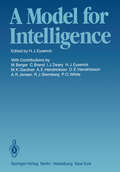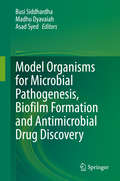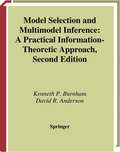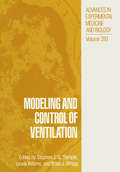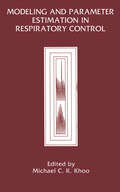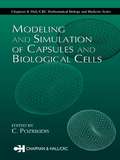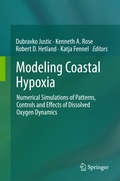- Table View
- List View
Model Development and Optimization (Applied Optimization #28)
by V.V. IvanovAt present, concerning intensive development of computer hardware and software, computer-based methods for modeling of difficult problems have become the main technique for theoretical and applied investigations. Many unsolved tasks for evolutionary systems (ES) are an important class of such problems. ES relate to economic systems on the whole and separate branches and businesses, scientific and art centers, ecological systems, populations, separate species of animals and plants, human organisms, different subsystems of organisms, cells of animals and plants, and soon. Available methods for modeling of complex systems have received considerable attention and led to significant results. No large-scale programs are done without methods of modeling today. Power programs, health programs, cosmos investigations, economy designs, etc. are a few examples of such programs. Nevertheless, in connection with the permanent complication of contemporary problems, existing means are in need of subsequent renovation and perfection. In the monograph, along with analysis of contemporary means, new classes of mathematical models (MM) which can be used for modeling in the most difficult cases are proposed and justified. The main peculiarities of these MM offer possibilities for the description ofES; creation and restoration processes; dynamics of elimination or reservation of obsolete technology in ES; dynamics of resources distribution for fulfillment of internal and external functions ofES; and so on. The complexity of the problems allows us to refer to the theory and applications of these MM as the mathematical theory of development. For simplicity, the title "Model Development and Optimization" was adopted.
Model Neural Networks and Behavior
by Allen SelverstonThe most conspicuous function of the nervous system is to control animal behav ior. From the complex operations of learning and mentation to the molecular con figuration of ionic channels, the nervous system serves as the interface between an animal and its environment. To study and understand the fundamental mecha nisms underlying the control of behavior, it is often both necessary and desirable to employ biological systems with characteristics especially suitable for answering specific questions. In neurobiology, many invertebrates have become established as model systems for investigations at both the systems and the cellular level. Large, readily identifiable neurons have made invertebrates especially useful for cellular studies. The fact that these neurons occur in much smaller numbers than those in higher animals also makes them important for circuit analysis. Although important differences exist, some of the questions that would be tech nically impossible to answer with vertebrates can become experimentally tractable with invertebrates.
Model Of Human Occupation: Theory And Application (PDF)
by Gary KielhofnerModel of Human Occupation, Fourth Edition offers a complete and current presentation of the most widely used model in occupational therapy, and delivers the latest in MOHO theory, research, and application to practice. This authoritative text explores what motivates individuals, how they select occupations and establish everyday routines, how environment influences occupational behavior, and more. NEW TO THIS EDITION: Case Vignettes that illustrate key concepts that students need to know Case Studies that help students apply the model to practice Chapter on evidence based practice (ch. 25) Chapter on World Health Organization and AOTA practice framework and language links the MOHO model to two widely used frameworks (ch. 27) Photographs of real patients help bring the concepts and cases to life
Model Organisms for Microbial Pathogenesis, Biofilm Formation and Antimicrobial Drug Discovery
by Busi Siddhardha Madhu Dyavaiah Asad SyedThis book provides essential insights into microbial pathogenesis, host-pathogen interactions, and the anti-microbial drug resistance of various human pathogens on the basis of various model organisms. The initial sections of the book introduce readers to the mechanisms of microbial pathogenesis, host-pathogen interactions, anti-microbial drug resistance, and the dynamics of biofilm formation. Due to the emergence of various microbial resistant strains, it is especially important to understand the prognosis for microbial infections, disease progression profiles, and mechanisms of resistance to antibiotic therapy in order to develop novel therapeutic strategies. In turn, the second part of the book presents a comparative analysis of various animal models to help readers understand microbial pathogenesis, host-pathogen interactions, anti-microbial drug discovery, anti-biofilm therapeutics, and treatment regimes. Given its scope, the book represents a valuable asset for microbiologists, biotechnologists, medical professionals, drug development researchers, and pharmacologists alike.
Model Organisms in Spinal Cord Regeneration
by Catherina G. Becker Thomas BeckerThis handbook provides a comprehensive overview for students, clinicians and researchers planning to enter the field of neural regeneration, combining the latest knowledge with an understanding of all important model organisms in one handy volume. By covering the strengths and weaknesses as well as possible applications of different models it saves researchers both time and resources in their choice of the appropriate model organism. An equally valuable introduction for the novice planning to enter the field.
Model Organisms to Study Biological Activities and Toxicity of Nanoparticles
by Busi Siddhardha Madhu Dyavaiah Kaviyarasu KasinathanThis book provides a comprehensive overview of state-of-the-art applications of nanotechnology in biology and medicine, as well as model organisms that can help us understand the biological activity and associated toxicity of nanoparticles, and devise strategies to minimize toxicity and enhance therapies. Thanks to their high surface-to-volume ratio, nanoparticles are characterized by excellent biocompatibility and bioavailability, a high therapeutic index, and relatively low toxicity, which has led to their widespread application in the early diagnosis of diseases, comprehensive monitoring of disease progression, and improved therapeutics. The book also explores nanoparticle-based insecticides and their mechanisms of action, and provides a comparative analysis of the various model organisms that are used to understand the biological properties of nanoparticles. Further, it describes various in-vivo models that yield important insights into nanomaterial-mediated toxicity, promoting the optimal utilization of nanoparticles. In closing, the book discusses future perspectives and regulatory issues concerning the use of nanomaterials in translational research.
Model Selection and Multimodel Inference: A Practical Information-Theoretic Approach
by Kenneth P. Burnham David R. AndersonA unique and comprehensive text on the philosophy of model-based data analysis and strategy for the analysis of empirical data. The book introduces information theoretic approaches and focuses critical attention on a priori modeling and the selection of a good approximating model that best represents the inference supported by the data. It contains several new approaches to estimating model selection uncertainty and incorporating selection uncertainty into estimates of precision. An array of examples is given to illustrate various technical issues. The text has been written for biologists and statisticians using models for making inferences from empirical data.
Model Systems of Development and Aging of the Nervous System
by Antonia Vernadakis Alain M. Privat Jean M. Lauder Paola S. TimirasThe last decade has generated a multitude of studies using in vitro model systems to explore growth and differentiation of the nervous system. Although the findings have been exciting and have revealed unique properties of neural cells, considerable concern continues to be expressed regarding the significance of in vitro findings in terms of their applicability to in vivo biological events. To examine this issue further, a group of scientists pre sented and discussed their findings at a conference sponsored by the Institute of Developmental Neuroscience and Aging held in Crete, Greece, 26-29 May 1985. The conference was cosponsored by the University of Crete and was generously supported by the Ministry of Research and Technology of Greece, Tourism Organization of Greece, and also Sandoz and FIDIA. The Directors of the Institute of Developmental Neuroscience and Aging are indebted to these Institutions for their support. For the success of this conference, the Directors owe much to Drs. Eleni Fleischer-Lambropoulos and Yiannis Tsouderos, who spent countless hours in making arrangements so that the participants would have not only a scientific, but also a unique cultural, experience. Several chapters of this book focus on the complex phenomena of neurogenesis and gliogenesis, and the modulation of neuronal differentiation. The concept that neuronal differentiation has both genetic and epigenetic components is documented by elegant studies using both in vitro cultured cells and neurons transplanted in vivo.
Modeling a New Computer Framework for Managing Healthcare Organizations: Balancing and Optimizing Patient Satisfaction, Owner Satisfaction, and Medical Resources
by Soraia OueidaThe medical sector has been growing exponentially over the last decade and healthcare services are becoming more complex and costly. In order to continue efficiently and effectively managing patient safety, quality, and the effectiveness of the healthcare systems, new methodologies are needed. This book provides a platform to address this growing need and to improve practice. With the introduction of a new computer platform package for the management of medical organizations and healthcare systems, Modeling a New Computer Framework for Managing Healthcare Organizations aims to improve management techniques and increase overall satisfaction scores of patients, owners, and medical resources. The platform outlined will improve the daily operation of a healthcare system, focusing on the emergency department, and can be used to study the operation flow of a unit for performance optimization. It offers a user-friendly interface and proposed programming language, along with a visual and simple practice to collect and understand statistical outputs. Essential reading for decision makers on different levels in the healthcare organization hierarchy, this book can also be used by management to improve the performance of the organization and decision makers to hire resources, enhance workflows or both. It guides designers and system implementers in a step-by-step approach to make optimal decisions for resource allocation and helps designers and management to detect deficiencies in ongoing processes and fix or enhance them.
Modeling a New Computer Framework for Managing Healthcare Organizations: Balancing and Optimizing Patient Satisfaction, Owner Satisfaction, and Medical Resources
by Soraia OueidaThe medical sector has been growing exponentially over the last decade and healthcare services are becoming more complex and costly. In order to continue efficiently and effectively managing patient safety, quality, and the effectiveness of the healthcare systems, new methodologies are needed. This book provides a platform to address this growing need and to improve practice. With the introduction of a new computer platform package for the management of medical organizations and healthcare systems, Modeling a New Computer Framework for Managing Healthcare Organizations aims to improve management techniques and increase overall satisfaction scores of patients, owners, and medical resources. The platform outlined will improve the daily operation of a healthcare system, focusing on the emergency department, and can be used to study the operation flow of a unit for performance optimization. It offers a user-friendly interface and proposed programming language, along with a visual and simple practice to collect and understand statistical outputs. Essential reading for decision makers on different levels in the healthcare organization hierarchy, this book can also be used by management to improve the performance of the organization and decision makers to hire resources, enhance workflows or both. It guides designers and system implementers in a step-by-step approach to make optimal decisions for resource allocation and helps designers and management to detect deficiencies in ongoing processes and fix or enhance them.
Modeling and Analysis of Shape with Applications in Computer-aided Diagnosis of Breast Cancer (Synthesis Lectures on Biomedical Engineering)
by Denise Guliato Rangaraj RangayyanMalignant tumors due to breast cancer and masses due to benign disease appear in mammograms with different shape characteristics: the former usually have rough, spiculated, or microlobulated contours, whereas the latter commonly have smooth, round, oval, or macrolobulated contours. Features that characterize shape roughness and complexity can assist in distinguishing between malignant tumors and benign masses. In spite of the established importance of shape factors in the analysis of breast tumors and masses, difficulties exist in obtaining accurate and artifact-free boundaries of the related regions from mammograms. Whereas manually drawn contours could contain artifacts related to hand tremor and are subject to intra-observer and inter-observer variations, automatically detected contours could contain noise and inaccuracies due to limitations or errors in the procedures for the detection and segmentation of the related regions. Modeling procedures are desired to eliminate the artifacts in a given contour, while preserving the important and significant details present in the contour. This book presents polygonal modeling methods that reduce the influence of noise and artifacts while preserving the diagnostically relevant features, in particular the spicules and lobulations in the given contours. In order to facilitate the derivation of features that capture the characteristics of shape roughness of contours of breast masses, methods to derive a signature based on the turning angle function obtained from the polygonal model are described. Methods are also described to derive an index of spiculation, an index characterizing the presence of convex regions, an index characterizing the presence of concave regions, an index of convexity, and a measure of fractal dimension from the turning angle function. Results of testing the methods with a set of 111 contours of 65 benign masses and 46 malignant tumors are presented and discussed. It is shown that shape modeling and analysis can lead to classification accuracy in discriminating between benign masses and malignant tumors, in terms of the area under the receiver operating characteristic curve, of up to 0.94. The methods have applications in modeling and analysis of the shape of various types of regions or objects in images, computer vision, computer graphics, and analysis of biomedical images, with particular significance in computer-aided diagnosis of breast cancer. Table of Contents: Analysis of Shape / Polygonal Modeling of Contours / Shape Factors for Pattern Classification / Classification of Breast Masses
Modeling and Control of Dialysis Systems: Volume 2: Biofeedback Systems and Soft Computing Techniques of Dialysis (Studies in Computational Intelligence #405)
by Ahmad Taher AzarThis book is the first text of its kind that presents both the traditional and the modern aspects of dialysis modeling and control in a clear, insightful and highly comprehensive writing style. It provides an in-depth analysis of the mathematical models and algorithms, and demonstrates their applications in real world problems of significant complexity. It explains concepts in a clear, matter-of-fact style. The material of this book will be useful to advanced undergraduate and graduate biomedical engineering students. Also, researchers and practitioners in the field of dialysis, control systems, soft computing will benefit from it. In order to make the reader aware of the applied side of the subject, the book includes: Chapter openers with a chapter outline, chapter objectives, key terms list, and abstract. Solved numerical examples to illustrate the application of a particular concept, and also to encourage good problem-solving skills. More than 1000 questions to give the readers a better insight to the subject. Case studies to understand the significance of the joint usage of the dialysis modeling and control techniques in interesting problems of the real world. latest information, including latest research surveys and references related to the subjects
Modeling and Control of Ventilation (Advances in Experimental Medicine and Biology #393)
by Stephen J. G. Semple Lewis Adams Brian J. WhippThe origins of what have come to be known as the "Oxford" Conferences on modelling and the control of breathing can be traced back to a discussion between Dan Cunningham and Richard Hercynski at a conference dinner at the Polish Academy of Sciences in 1971. Each felt that they had benefited from the different perspectives from which the topic of ventilatory control was approached - predominantly physiological in the case of Dr Cunningham and predominantly mathematical in the case of Dr Hercynski. Their judgement at that time was that a conference on the control of breathing which allowed investigators with these different (but related) scientific perspectives to present and discuss their work, might prove fruitful. We would judge that this has amply been borne out, based upon the success of the series of conferences which resulted from that seminal dinner conversation. The first conference, entitled "Modelling of a Biological Control System: The Regulation of Breathing" was held in Oxford, UK, in 1978. Subsequent conferences were: "Modelling and the Control of Breathing" at Lake Arrowhead, California, in 1982; "Con cepts and Formulations in the Control of Breathing" in Solignac, France, in 1985; "Respi ratory Control: A Modeling Perspective" at Grand Lakes, Colorado, in 1988; and "Control of Breathing and Its Modelling Persepctive" at the Fuji Institute in Japan in 1991. The conferences, subsequent to the one in Oxford, have all resulted in well-received published proceedings.
Modeling and Management of Resources under Uncertainty: Proceedings of the Second U.S.-Australia Workshop on Renewable Resource Management held at the East-West Center, Honolulu, Hawaii, December 9–12, 1985 (Lecture Notes in Biomathematics #72)
by Thomas L. Vincent Yosef Cohen Walter J. Grantham Geoffrey P. Kirkwood Jan M. SkowronskiThis vol ume contains the proceedings of the second U. S. -Austral ia workshop on Renewable Resource Management held at the East-West Center, Honolulu, Hawaii, December 9-12, 1985. The workshop was jointly sponsored by the National Science Foundation (USA) and the Department of Science and Technology (Austral ia) under the U. S. -Austral ia Cooperative Science Program. The objective of the workshop was to focus on problems associated with the management of renewable resource systems. A particular emphasis was given to methods for handling uncertain elements whieh are present in any real system. Toward this end, the partiei pants were chosen so that the collective expertise included mathematical modeling, dynamical control/game theory, ecology, and practical management of real systems. Each participant was invited to give an informal presentation in his field of expertise as related to the overall theme. The formal papers (contained in this vo 1 ume) were written after the workshop so that the authors coul d util ize the workshop experience in relating their own work to others. To further encourage this exchange, each paper contained in this volume was reviewed by two other participants who then wrote formal comments. These comments (with author's reply in some cases) are attached to the end of each paper.
Modeling and Parameter Estimation in Respiratory Control
by M. C. K. KhooExperimentalists tend to revel in the complexity and multidimensionality of biological processes. Modelers, on the other hand, generally look towards parsimony as a guiding prin ciple in their approach to understanding physiological systems. It is therefore not surprising that a substantial degree of miscommunication and misunderstanding still exists between the two groups of truth-seekers. However, there have been numerous instances in physiology where the marriage of mathematical modeling and experimentation has led to powerful in sights into the mechanisms being studied. Respiratory control represents one area in which this kind of cross-pollination has proven particularly fruitful. While earlier modeling ef forts were directed primarily at the chemical control of ventilation, more recent studies have extended the scope of modeling to include the neural and mechanical aspects pertinent to respiratory control. As well, there has been a greater awareness of the need to incorpo rate interactions with other organ systems. Nevertheless, it is necessary from time to time to remind experimentalists of the existence of modelers, and vice versa. The 4th Annual Biomedical Simulations Resource (BMSR) Short Course was held in Marina Del Rey on May 21-22,1989, to acquaint respiratory physiologists and clinical researchers with state-of-the art methodologies in mathematical modeling, experiment design and data analysis, as well as to provide an opportunity for experimentalists to challenge modelers with their more recent findings.
Modeling and Simulation: A Memorial Volume for Professor Walter J. Karplus (1927–2001)
by George A. Bekey Boris Ja. KoganModeling and Simulation: Theory and Practice provides a comprehensive review of both methodologies and applications of simulation and modeling. The methodology section includes such topics as the philosophy of simulation, inverse problems in simulation, simulation model compilers, treatment of ill-defined systems, and a survey of simulation languages. The application section covers a wide range of topics, including applications to environmental management, biology and medicine, neural networks, collaborative visualization and intelligent interfaces. The book consists of 13 invited chapters written by former colleagues and students of Professor Karplus. Also included are several short 'reminiscences' describing Professor Karplus' impact on the professional careers of former colleagues and students who worked closely with him over the years.
Modeling and Simulation of Capsules and Biological Cells
by C. PozrikidisIn the past three decades, considerable progress has been made in the mathematical analysis, modelling, and simulation of the fluid dynamics of liquid capsules and biological cells, and interest in this area is now at an all-time high. This book features a collection of chapters contributed by acknowledged leaders in the field who explore topics re
Modeling and Simulation of Capsules and Biological Cells (Chapman And Hall/crc Mathematical Biology Ser.)
by C. PozrikidisIn the past three decades, considerable progress has been made in the mathematical analysis, modelling, and simulation of the fluid dynamics of liquid capsules and biological cells, and interest in this area is now at an all-time high. This book features a collection of chapters contributed by acknowledged leaders in the field who explore topics re
Modeling Binary Correlated Responses: Using SAS, SPSS, R and STATA (ICSA Book Series in Statistics)
by Jeffrey R. Wilson Kent A. Lorenz Lori P. SelbyThis book is an updated edition of Modeling Binary Correlated Responses Using SAS, SPSS and R, and now it includes the use of STATA. It uses these Statistical tools to analyze correlated binary data, accessible to practitioners in a single volume. Chapters cover recently developed statistical tools and statistical packages, as well as showcase both traditional and new methods for application to health-related research. Data analysis presented in each chapter will provide step-by-step instructions so these new methods can be readily applied to projects. Short tutorials are in the appendix, for readers interested in learning more about the languages. Data and computer programs will be publicly available in order for readers to replicate model development, but learning a new statistical language is not necessary with this book. The inclusion of code for R, SAS, SPSS and STATA, allows for easy implementation by readers. Researchers and graduate students in Statistics, Epidemiology, and Public Health will find this book particularly useful.
Modeling Binary Correlated Responses using SAS, SPSS and R (ICSA Book Series in Statistics #9)
by Jeffrey R. Wilson Kent A. LorenzStatistical tools to analyze correlated binary data are spread out in the existing literature. This book makes these tools accessible to practitioners in a single volume. Chapters cover recently developed statistical tools and statistical packages that are tailored to analyzing correlated binary data. The authors showcase both traditional and new methods for application to health-related research. Data and computer programs will be publicly available in order for readers to replicate model development, but learning a new statistical language is not necessary with this book. The inclusion of code for R, SAS, and SPSS allows for easy implementation by readers. For readers interested in learning more about the languages, though, there are short tutorials in the appendix. Accompanying data sets are available for download through the book s website. Data analysis presented in each chapter will provide step-by-step instructions so these new methods can be readily applied to projects. Researchers and graduate students in Statistics, Epidemiology, and Public Health will find this book particularly useful.
Modeling Biomolecular Networks in Cells: Structures and Dynamics
by Luonan Chen Ruiqi Wang Chunguang Li Kazuyuki AiharaModeling Biomolecular Networks in Cells shows how the interaction between the molecular components of basic living organisms can be modelled mathematically and the models used to create artificial biological entities within cells. Such forward engineering is a difficult task but the nonlinear dynamical methods espoused in this book simplify the biology so that it can be successfully understood and the synthesis of simple biological oscillators and rhythm-generators made feasible. Such simple units can then be co-ordinated using intercellular signal biomolecules. The formation of such man-made multicellular networks with a view to the production of biosensors, logic gates, new forms of integrated circuitry based on "gene-chips" and even biological computers is an important step in the design of faster and more flexible "electronics". The book also provides theoretical frameworks and tools with which to analyze the nonlinear dynamical phenomena which arise from the connection of building units in a biomolecular network.
Modeling Biomolecular Site Dynamics: Methods and Protocols (Methods in Molecular Biology #1945)
by William S. HlavacekThis volume covers a variety of topics related to the practice of rule-based modeling, a type of mathematical modeling useful for studying biomolecular site dynamics. There is an emphasis on software tools and detailed descriptions of techniques. The chapters in this book discuss topics such as software tools and frameworks for compartmental modeling (Pycellerator, RuleBuilder, Prgy, rxncon, MSMB, and ML-Rules); tools for spatial modeling (Simmune, Smoldyn, MCell-R, SRSim, and CellOrganizer); rule-based models to analyze proteomic data; model annotation; Markov chain aggregation; BioJazz; and methods to identify model parameters (Data2Dynamics, RKappa, and BioNetFit). Written in the highly successful Methods in Molecular Biology series format, chapters include introductions to their respective topics, lists of the necessary resources, step-by-step, readily reproducible protocols, and tips on troubleshooting and avoiding known pitfalls.Cutting-edge and thorough, Modeling Biomolecular Site Dynamics: Methods and Protocols is a valuable resource for both the novice and expert rule-based modeler. It will also appeal to systems biologists and help them enhance their studies with easy-to-read and write rule-based models.
Modeling Coastal Hypoxia: Numerical Simulations of Patterns, Controls and Effects of Dissolved Oxygen Dynamics
by Dubravko Justic Kenneth A. Rose Robert D. Hetland Katja FennelThis book provides a snapshot of representative modeling analyses of coastal hypoxia and its effects. Hypoxia refers to conditions in the water column where dissolved oxygen falls below levels that can support most metazoan marine life (i.e., 2 mg O2 l-1). The number of hypoxic zones has been increasing at an exponential rate since the 1960s; there are currently more than 600 documented hypoxic zones in the estuarine and coastal waters worldwide. Hypoxia develops as a synergistic product of many physical and biological factors that affect the balance of dissolved oxygen in seawater, including temperature, solar radiation, wind, freshwater discharge, nutrient supply, and the production and decay of organic matter. A number of modeling approaches have been increasingly used in hypoxia research, along with the more traditional observational and experimental studies. Modeling is necessary because of rapidly changing coastal circulation and stratification patterns that affect hypoxia, the large spatial extent over which hypoxia develops, and limitations on our capabilities to directly measure hypoxia over large spatial and temporal scales. This book consists of 15 chapters that are broadly organized around three main topics: (1) Modeling of the physical controls on hypoxia, (2) Modeling of biogeochemical controls and feedbacks, and, (3) Modeling of the ecological effects of hypoxia. The final chapter is a synthesis chapter that draws generalities from the earlier chapters, highlights strengths and weaknesses of the current state-of-the-art modeling, and offers recommendations on future directions.
Modeling, Control and Drug Development for COVID-19 Outbreak Prevention (Studies in Systems, Decision and Control #366)
by Ahmad Taher Azar Aboul Ella HassanienThis book is well-structured book which consists of 31 full chapters. The book chapters' deal with the recent research problems in the areas of modeling, control and drug development, and it presents various techniques of COVID-19 outbreak prevention modeling. The book also concentrates on computational simulations that may help speed up the development of drugs to counter the novel coronavirus responsible for COVID-19.This is an open access book.

